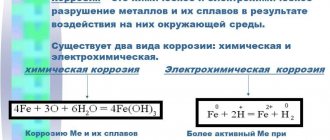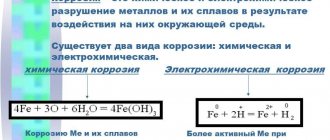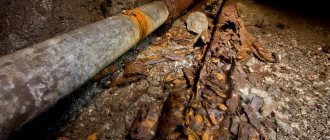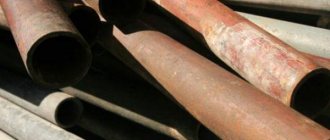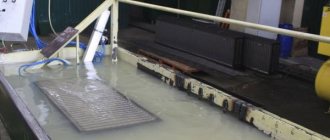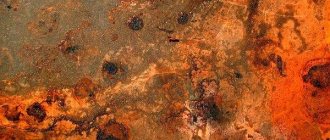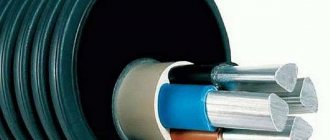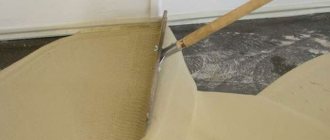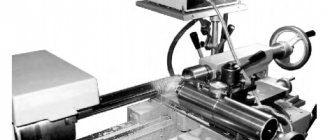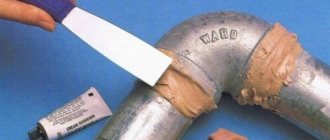Types of corrosion
Aluminum oxidizes quickly in the atmosphere, but to a shallow depth. This is prevented by a protective oxide film. Oxidation accelerates above the melting point of aluminum. If the integrity of the oxide film is compromised, aluminum begins to corrode. The reasons for the thinning of its protective layer can be various factors, from exposure to acids, alkalis and ending with mechanical damage.
Aluminum corrosion is the self-destruction of metal under the influence of the environment. According to the flow mechanism, they are distinguished:
- Chemical corrosion - occurs in a gas environment without the participation of water.
- Electrochemical corrosion – occurs in humid environments.
- Gas destruction - but accompanies heating and hot processing of aluminum. As a result of the interaction of oxygen with metals, a dense oxide film appears. This is why aluminum does not rust, like all non-ferrous metals.
On video: electrochemical corrosion of metals and methods of protection.
Battery principle
Galvanic corrosion works like a battery, which consists of two electrodes:
- cathode where the reduction reaction occurs
- anode where the oxidation reaction occurs.
These two electrodes are immersed in a conductive liquid called an electrolyte. An electrolyte is usually a dilute acid solution, such as sulfuric acid, or a saline solution, such as copper sulfate. These two electrodes are connected externally by an electrical circuit that allows electrons to circulate. Inside a liquid, electric current is transmitted by the movement of ions. The liquid thus provides an ionic electrical connection (Figure 9).
Figure 9 – Principle of a galvanic cell [3]
Figure 1 shows a cell in which the electrolyte is a sulfuric acid solution. Sulfuric acid is completely dissociated in water (since it is a strong acid) by forming H+ ions, which determine the acidity of the medium. The following electrochemical reaction occurs [3]:
- The zinc anode is oxidized:
Zn → Zn2+ + 2e−
H+ protons are reduced at the copper cathode:
2Н+ + 2e− → Н2
The complete reaction looks like:
Zn + H2O → Zn(OH)2 + H2
This cell produces electricity by consuming zinc, which is released as zinc hydroxide Zn(OH)2.
For the cell to operate, three conditions must be met simultaneously:
- two different metals that form two electrodes;
- presence of electrolyte;
- continuity of the entire electrical chain.
If any of these conditions are not met, for example if the electrical contact is broken, then the cell will not produce electricity and oxidation at the anode will not occur (nor reduction at the cathode).
Causes of aluminum corrosion
The corrosion resistance of aluminum depends on several factors:
- purity - the presence of impurities in the metal;
- exposure environment - aluminum can be equally susceptible to destruction in clean rural air and in industrially polluted areas;
- temperature.
In many cases, low-concentration acids can dissolve aluminum. The natural oxide film does not protect against corrosion.
Powerful destroyers are fluorine, potassium, sodium. Aluminum and its alloys corrode when exposed to chemical compounds of bromine and chlorine, lime and cement solutions.
Corrosion of aluminum and its alloys occurs in water, air, carbon and sulfur oxides, and salt solutions. Sea water leads to accelerated destruction. Aluminum is considered an active metal, but it also has good corrosion properties.
There are two main factors that influence the intensity of the corrosion process:
- degree of aggressiveness of the acting environment - humidity, pollution, smoke;
- chemical structure.
Aluminum does not corrode in clean water. Heating and steam do not affect the protective oxide film.
How does water affect the metal being described?
Corrosion of aluminum in water can occur from damage to the top layer and protective film. The high temperature of the liquid contributes to the rapid destruction of the metal. If aluminum is placed in fresh water, then corrosion processes will practically not be observed. If you increase the water temperature, you may not notice any changes. When the liquid heats up to a temperature of 80 degrees or higher, the metal begins to deteriorate.
The corrosion rate of aluminum increases if alkali gets into the water. The described metal is hypersensitive to salt. That is why sea water is destructive for it. To use this metal in seawater, it is necessary to add magnesium or silicon to the liquid. If you use a sheet of aluminum that contains copper, then corrosion of the alloy will occur much faster than that of a pure substance.
Manifestation of aluminum corrosion
The following types of corrosion of aluminum and its alloys are distinguished:
- Superficial – the most common, causes the least harm, is easily noticeable and can be quickly eliminated.
- Local – destruction is observed in the form of depressions and spots. A dangerous type of corrosion due to its invisibility. Found in hard-to-reach parts and assemblies of metal structures.
- Thread-like, filigree - observed under organic coatings, on weakened areas of the surface.
Any type of corrosion of aluminum structures causes destruction.
This shortens the life of the products. In a galvanic couple, aluminum can corrode while protecting the other metal.
The natural anti-corrosion properties of aluminum and its alloys are not enough. Therefore, mechanisms, assemblies, structures and metal products need additional protection.
Aluminum sheets for shipbuilding
Often, when building ships, materials are required in accordance with industry standards, in particular OST1 92063-78 plates of aluminum alloys for shipbuilding and OST1 92073-82 sheets of aluminum alloys for shipbuilding. If necessary, such sheets can be supplied upon your request. The main material according to these standards is sheets and plates made of alloy 1561. Please note that these standards do not provide for the use of AMg6 sheets and plates. But sometimes even these strict requirements are not enough! The requirements of modern shipbuilders are strict - the materials needed are aluminum sheets with a register!
Ways to combat corrosion
Corrosion protection is carried out in several ways:
- Mechanical paint and varnish protective coating.
- Electrochemical protection – coating with more active metals;
- Coating of aluminum with powder compositions, the so-called aluminizing process;
- High voltage anodizing;
- Chemical oxidation;
- Application of corrosion inhibitors.
Mechanical coating
How to protect aluminum from corrosion? The most commonly used mechanical method is applying a layer of paint.
Paint the product and you will see the effectiveness of this method. Painting can be wet and dry, or powder. These technologies will improve. In wet painting, paint layers are applied after protecting the aluminum with a composition containing zinc and strontium compounds. The metal base is carefully prepared: protected, polished, dried. The primer is applied in stages.
When the solvent from the primer mixture has completely disappeared, the surface can be coated with an insulating composition: oil or glyphthalic varnish.
Special compounds help stop corrosion and protect aluminum structures from chemicals, gasoline, and various types of oils. The choice of coating depends on the conditions of subsequent use of the metal product:
- hammer - used to obtain structures of various color shades used in decoration;
- bakelite - applied under high pressure, filling microcracks and pores.
Powder painting requires thorough cleaning of the surface from grease and various deposits. This is achieved by immersion in alkaline or acidic solutions with the addition of wetting agents. Next, a layer of chromate, phosphate, zirconium or titanium compounds is applied to the aluminum structures. After this it will not oxidize.
After drying the material, a protective polymer is applied to the oxidized area. The most commonly used are polyesters that are resistant to mechanical, chemical and thermal influences. Polymerized urethane, epoxy and acrylic powders are used.
Aluminum sheets with certificate RMRS - Russian Maritime Register of Shipbuilding
In shipbuilding, aluminum plates, aluminum sheets and other rolled products that have a certificate of conformity with the Russian Maritime Register of Shipbuilding or the international Lloyd's Maritime Register are increasingly being requested. Nevskaya Aluminum Company can offer the supply of aluminum sheets 1550 and 5083 (analogous to AMg5) and aluminum sheets 1561 (analogous to AMg6), meeting the requirements of Part XIII “Materials” of the Rules for the Classification and Construction of Sea Vessels (under the supervision of the Register) with a mark of conformity in the certificate of material of aluminum sheets .
At Nevskaya Aluminum Company you can buy from a warehouse in St. Petersburg or Moscow various types of aluminum sheets and plates for shipbuilding:
- Buy aluminum sheets AMg3
- Buy aluminum sheets AMg5
- Buy aluminum sheets AMg6
- Buy aluminum sheets 1561
- Buy aluminum sheets 5083
- Buy aluminum plates AMg6
- Buy aluminum plates 1561
- Buy aluminum welding wire
- Buy corrugated aluminum sheet at retail in St. Petersburg
- Buy rectangular aluminum pipes
- Buy square pipes Ad31
- Buy inexpensive aluminum corners
- Buy aluminum strips
Aluminum oxidation
Aluminum oxidation occurs at direct current under a voltage of 250 V. The protective film is grown at room temperature with water cooling. No pulse source required. The films are obtained dense and durable within 45-60 minutes.
The density and color of the oxide coating are affected by the temperature of the electrolyte:
- low temperature forms a dense film of bright color;
- increased - forms a loose film that requires further painting.
Aluminum can be protected from corrosion by an electrochemical reaction. The process is divided into several stages:
1. At the preparation stage, the aluminum product is degreased by immersing it in a solution of oxalic acid.
2. After washing with water, immerse in an alkaline solution to remove the unevenly formed oxide layer.
3. For additional coloring, aluminum products are immersed in appropriate salt solutions. To fill the formed pores, the metal material is treated with steam.
4. The product is then dried. Anodic oxidation can be carried out using alternating current.
To protect against corrosion, chemical oxidation is used - it is less expensive and does not require special electrical equipment and qualifications of performers. A simple chemical composition is used.
During the aluminizing process, the resulting oxide film 3 microns thick has a light green color, has high electrical insulating properties, is non-porous, and does not stain.
Corrosion of aluminum occurs due to nearby metals that have oxidized. Isolation helps prevent this process. These can be gaskets made of rubber, bitumen, paronite. When covering with rust, varnish and other insulating materials are used. There are no other ways to get rid of this problem yet.
